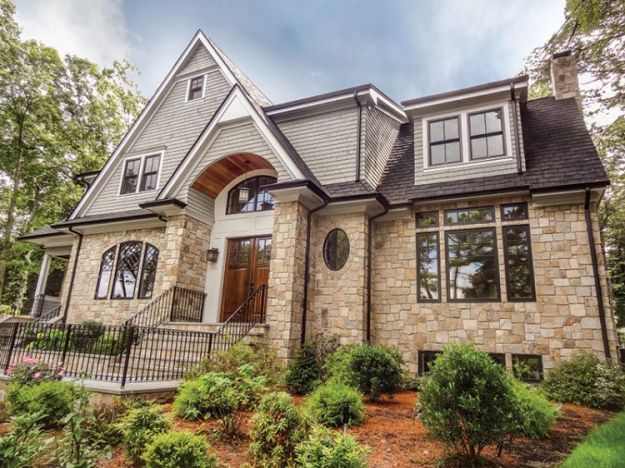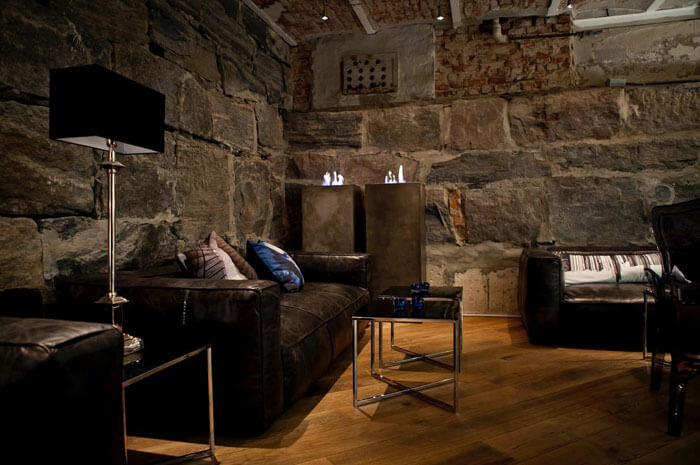House Siding Materials You Probably Never Heard of!
The primary purpose of any siding material is to add a layer of protection and insulation to your home thereby protecting it from the outer elements.
Keeping the above in mind, other decisions that go into determining the best approach to a house siding project, whether you do it yourself or hire a professional, including curb appeal and the not-so-common materials can be put in proper perspective.
Stucco
Some think of stucco as popular in certain regions like Southern California, without realizing there are likely stucco homes in their own neighborhood.
 Image source: View-Master Home Inspections
Image source: View-Master Home Inspections
Our view is that stucco is a viable, long-lasting and architecturally-attractive material that complements other house siding options.
Made from sand, cement, lime and water, the material is usually applied to a galvanized steel screen, along with waterproof underlayment glued to a wood frame.
The stucco material itself isn’t all that versatile and instead is rather quite rigid, needing special care during installation to avoid cracks. But given that it is a hard material, it will last the life of a home, or at least 50+ years.
Costs: for stucco are around $8.50 to $14.50 per sq. ft. installed, depending on the quality of materials, who’s doing the work and location of the property.
An average-sized home will cost between $17,000 and $28,000 for new traditional stucco siding, including installation.
Pros: Very durable, low maintenance, great insulator, colors go through mix so repainting not necessary, resistant to fire and insects
Cons: Fairly expensive, takes skill to install, brittle material prone to cracking especially due to settling of a house, a sinking foundation, or even a mild earthquake. Not a good option for wet climates, tends to last less time in climates with lots of rain.
If the stucco material becomes saturated with water due to constant dampness or gutter leaks, then its insulation properties will be compromised and structural damage to the house may ensue.
Brick and Brick Veneer
Brick as a siding material has been used for hundreds of years. It has a masonry appearance with architectural uniformity. Made from fired clay, brick comes in different sizes and textures.
Because a whole brick isn’t technically needed for siding, the front face or say 1/3rd of a brick is all that may used, thus the brick veneer becomes an option.
Yet, with this option comes more chance for water to penetrate the material and so a membrane, leak-proof material is necessary below the veneer so water doesn’t leak into the frame of the structure.
Brick is among the most durable materials and routinely lasts the lifetime of a home, or at least 50+ years.
Cost: Brick itself is an expensive material, costing around $6.00 to $15.00 per sq. ft. for materials alone.
On average, you can expect to pay between $12.00 – $25.00 per sq. ft. of brick siding installed.
If you like the look of brick but wish to lower the cost, the brick veneer option can help — reducing the price per sq. ft. down to between $9.50 and $17.50 per sq. ft. installed
While we are really including 2 products in this one entry, the ranking is based on actual brick.
The veneer option for brick would have it rank higher on the list, but not be fair to other items that also could cut corners from what people tend to think of when first considering the material.
An average-sized home will cost between $24,000 and $50,000 for standard brick siding, including installation.
Note: The cost for brick siding can vary quite a bit, depending on the type of project, material choice, and your home’s location.
Pros: stands up very well to weather, fire and insects, lasts a long time
Cons: very expensive, more challenging to install (not a great DIY project unless experienced)
Stone and Stone Veneer
All types of stone material can be used in siding a home, but granite and limestone are the most popular. It holds high appeal because of its known durability and visual appearance of a texture unmatched by other materials.
While it is the most expensive material, a stone veneer option allows for costs to be reduced.
The veneer is lighter weight due to it being made of composite materials. Plus, stone is rarely covering the entire facade of a home and instead is used as a way to accent features.
Stone has durability that works on several levels. Almost all other materials on the list will fade over time, but stone won’t. It’ll easily last the life of a home and is in the 50+ years category for lifespan.
If our list were based on the best investment, stone would be hard not to put at the top of the list.
Cost: When we say expensive, we mean very expensive. Stone costs $25 to $45 per sq. ft. installed, or a good 5 to 10 times more expensive than the item at the top of this list.
The price range for total cost to side a home (below) needs to be stipulated with the idea that veneer option would lower the cost and it’s unlikely that someone would use all stone as their only siding material. Though the high-end price does assume just that.
An average-sized home will cost between $40,000 and $70,000 for standard stone siding, including installation.
Pros: Most durable, least flammable, least likely to be infested by insects or animals, low maintenance, being natural makes it inherently Eco-friendly
Cons: Expensive, very heavy, takes expertise to install
Metal – Aluminum, Steel, Zinc, and Copper
At first glance, metal as a siding material conjures up images of modern homes. But aluminum siding is a horizontal lap variation that mimics traditional home siding.
Metal is truly one of the most versatile materials on the list as it can be factory shaped and colored in a great variety of ways. The material is certainly durable, and will last 40+ years.
Cost: will depend on the type of metal siding and how it is being applied. Low end costs per sq. ft. range from $8.50 to $15.00 installed.
An average-sized home will cost between $17,000 and $25,000 for standard metal siding, including installation.
Pros: low cost, highly durable, good insulation, is Eco-friendly (material is fully-recyclable), fire and insect resistant
Cons: takes skill to install, maintenance issues as color will not last as long as material, can dent, look is not for everyone, which for this material is more true than others, may be noisy
Conclusion
There are many inferences to be drawn from such a list as this. Vinyl is a durable material that last longer and is easier to maintain than say wood. Metal can last nearly as long as stone, but costs far less.
If we had gone with what is best investment option, it would almost be in reverse order, though wood in some ways is likely the least practical investment, and still the type of material that most others are trying to appear like.
Other Viable Alternatives: Fiber Cement is a favorite among many with high satisfaction among its owners, but isn’t quite as durable as vinyl and costs more. Cement is a traditional material and well known, yet has about the same impact in terms of costs and protection as stucco.
If live in a climate that does not receive a lot of rain, then LP SmartSide engineered wood siding is another smart option to consider. It’s durable and long lasting, but we wouldn’t recommend installing it in the Pacific Northwest.
Pricing Research Disclosures: In our research, costing information wasn’t necessarily always clear cut nor the same according to all sources.
We did our best to stick with the average costs per square foot installed and provided the price range that is fairly broad to account for material quality variations and regional differences (coastal metros vs. rural areas) in installation costs.
Note: Professional installation costs can very a lot. Expect to pay more on per square foot basis for any siding option installed in or near a large coastal city compared to less-costly areas such as Midwest.
Design of siding is a topic that could use further exploration. In this guide, we chose to focus on material properties or function and how that impacts costs.
Source: https://www.roofingcalc.com/stone-siding-cost-vs-stucco-and-brick-veneer







Leave a comment
This site is protected by hCaptcha and the hCaptcha Privacy Policy and Terms of Service apply.